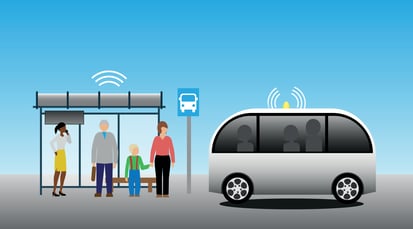Wi-Fi HaLow is the Ideal Technology for LTE Device Aggregation and LTE Offloading
 LTE connections can be quite expensive, and companies do not want to pay a monthly subscription fee for each IoT device. Various wireless technologies have attempted to expand the coverage area for LTE offloading or LTE device aggregation and faced a multitude of complications. However, Wi-Fi HaLow offers a unique combination of extended range, high data throughput, and signal penetration, making it the ideal choice for offloading LTE connections. This can be accomplished through either a dedicated network connection or LTE device aggregation using an LTE to HaLow access point. Numerous examples of this technology are currently under development and available on the market. While cellular technology remains the most versatile wireless technology, Wi-Fi HaLow is a close alternative option without the associated recurring costs.
LTE connections can be quite expensive, and companies do not want to pay a monthly subscription fee for each IoT device. Various wireless technologies have attempted to expand the coverage area for LTE offloading or LTE device aggregation and faced a multitude of complications. However, Wi-Fi HaLow offers a unique combination of extended range, high data throughput, and signal penetration, making it the ideal choice for offloading LTE connections. This can be accomplished through either a dedicated network connection or LTE device aggregation using an LTE to HaLow access point. Numerous examples of this technology are currently under development and available on the market. While cellular technology remains the most versatile wireless technology, Wi-Fi HaLow is a close alternative option without the associated recurring costs.
LTE Device Aggregation with Wi-Fi HaLow
LTE device aggregation involves connecting multiple sensors and devices to a single access point that is connected to a cellular network. Wi-Fi HaLow to LTE gateways can be used to reduce the number of required cellular connections. A single HaLow access point can cover an area of up to 2.73 square miles in ideal conditions. Assuming there are multiple devices in an outdoor environment, Wi-Fi HaLow could combine these multiple LTE devices into one LTE connection to cover IoT deployments for various purposes such as smart cities, agriculture, critical infrastructure, and oil fields.
LTE Offloading
Wi-Fi HaLow can eliminate the need for LTE connections by directly connecting an access point to the internet, allowing you to have total ownership of your infrastructure. Especially if you have a roaming device in a limited area, using Wi-Fi HaLow instead of LTE may be preferable. This would be particularly beneficial for any remote locations that lack LTE coverage but require device roaming capabilities, such as the mining, logging, or critical infrastructure monitoring industries.
What Does Wi-Fi HaLow Do Better
The goal is to minimize the number of subscription-based connections and reduce operating costs. Wi-Fi HaLow covers a large range by default and can extend to even farther in a mesh configuration, surpassing every other wireless technologies except for low data rate LPWANs. The data speed of a Wi-Fi HaLow network is significantly faster than LoRa and Bluetooth Low Energy, making it capable of supporting demanding applications such as cameras and videos, rather than just a sensor network. It can also support thousands of devices from a single access point, allowing for dense IoT deployments. Wi-Fi HaLow stands out as the perfect wireless technology partner for LTE device aggregation or LTE offloading thanks to the right mix of data throughput, range, and connection support it offers. Let's explore some real-world examples that showcase the benefits of HaLow.
Smart City Example
 For our first example, let’s retrofit a city’s bus stops with connectivity for monitoring each bus stop and connecting digital signage. Breaking up the concrete and installing fiber internet connections and hardwiring each bus stop is likely way too expensive to consider. The simplest idea would be to connect each bus stop with LTE technology but then you’re paying a monthly cost for each bus stop. So you are probably going to want to aggregate as many bus stations as you can for the cost saving. Traditional Wi-Fis such as Wi-Fi 4, 5, and 6 would probably connect to a bus station across the street going the other way, possibly covering half of the bus stops which is still not ideal. In such scenarios, Wi-Fi HaLow would be the ideal solution. According to TransitWiki, the average distance between bus stations is often less than a quarter mile apart. This means one Wi-Fi HaLow AP assuming a one-mile range could reach 9 bus stations on each side for a total of 18 bus stations – reducing the cost of operating expenses by 95% compared to cellular. Notwithstanding such a long-range coverage with no service fee, Wi-Fi HaLow is the sole wireless technology providing Mbps-level data throughput enough to update digital signage and provide camera images of each bus station. This could increase the safety of passengers through monitoring, updating bus arrival times, tracking bus locations, updating digital advertisements, and monitoring bus stop usage for the potential of reducing the monthly costs to under a tenth of adding an LTE modem to each bus stop.
For our first example, let’s retrofit a city’s bus stops with connectivity for monitoring each bus stop and connecting digital signage. Breaking up the concrete and installing fiber internet connections and hardwiring each bus stop is likely way too expensive to consider. The simplest idea would be to connect each bus stop with LTE technology but then you’re paying a monthly cost for each bus stop. So you are probably going to want to aggregate as many bus stations as you can for the cost saving. Traditional Wi-Fis such as Wi-Fi 4, 5, and 6 would probably connect to a bus station across the street going the other way, possibly covering half of the bus stops which is still not ideal. In such scenarios, Wi-Fi HaLow would be the ideal solution. According to TransitWiki, the average distance between bus stations is often less than a quarter mile apart. This means one Wi-Fi HaLow AP assuming a one-mile range could reach 9 bus stations on each side for a total of 18 bus stations – reducing the cost of operating expenses by 95% compared to cellular. Notwithstanding such a long-range coverage with no service fee, Wi-Fi HaLow is the sole wireless technology providing Mbps-level data throughput enough to update digital signage and provide camera images of each bus station. This could increase the safety of passengers through monitoring, updating bus arrival times, tracking bus locations, updating digital advertisements, and monitoring bus stop usage for the potential of reducing the monthly costs to under a tenth of adding an LTE modem to each bus stop.
Critical Infrastructure Example
Often times, critical infrastructure such as a riverbank can be large, without power, and possibly remote. Monitoring such a large stretch of land could be done with LTE-M-enabled sensors; however, Wi-Fi HaLow would not only be effective, but also offers lower power consumption and lower operating costs. A single Wi-Fi HaLow AP could reach 1 mile in each direction, effectively covering 2 miles of the riverbank. Each AP could also support a wide range of devices such as cameras for visual monitoring of the riverbanks, water monitoring sensors to measure water level, and connected current meters to measure water flow. Wi-Fi HaLow can support multi-year battery life making it feasible to be deployed in remote areas without power, with the data throughput to support higher data-driven applications such as visual monitoring. A HaLow AP could connect directly to a network if one was available, cutting out the need for any LTE connection. This would leave recurring maintenance costs low and limited to device failure replacements and the manpower to service the batteries.
Electric Car Charging Example
Companies looking to install electric car charging stations face numerous challenges, as they are often installed on someone else’s infrastructure. One major challenge is establishing a reliable connection to enable payments for use. Laying down a network cable involves cutting through a lot of asphalt, which can be expensive. While LTE is an option, it adds to the overall cost. Traditional Wi-Fi could be used to connect to infrastructure, but parking lots are typically large, and signal transmission through thick walls can be challenging. Moreover, unknown interference from mobile phones and Bluetooth devices can affect signal quality. Wi-Fi HaLow operates at a sub-gig frequency, which helps to avoid many of these issues and ensures connection reliability between stations. With a range ten times greater than traditional Wi-Fi, Wi-Fi HaLow provides greater flexibility on where infrastructure can be installed, making it ideal for large concrete structures like parking garages. Finally, Wi-Fi HaLow uses the latest in Wi-Fi security, WPA3, ensuring the safe transmission of payment information.
Conclusion
Today, LTE device aggregation is possible using various wireless technologies such as LoRa, Wi-Fi, and BLE. However, Wi-Fi HaLow stands out as the best option that strikes a balance between data throughput, low power consumption, range, and signal penetration for LTE device aggregation without the recurring costs. As the frontier of Wi-Fi HaLow, NEWRACOM is working with various customers who are developing innovative solutions using Wi-Fi HaLow to reduce the number of LTE-enabled devices they require. If you have an idea of how Wi-Fi HaLow can be used, feel free to contact us through our contact page.



